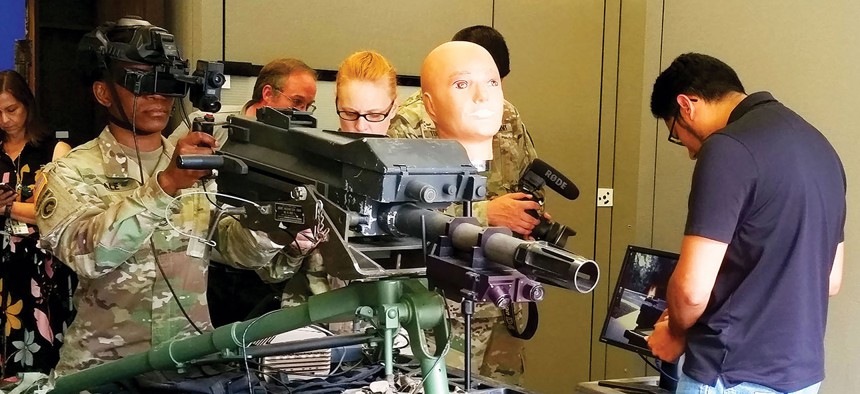
Sgt. 1st Class Taikeila Dale uses the Mk-19 simulator with augmented reality head-mounted display in August. C. Todd Lopez/Army
Army Eyes Faster Weapons Development with a New Collaboration Hub
Super-strong materials, cyber defenses are on the agenda as the Army Research Lab launches new partnerships.
When the Pentagon wanted to expand its tech outreach beyond Silicon Valley, officials looked to Boston, opening the second DIUx location there in 2016. The Army Research Laboratory is now joining them, setting up its own “open campus” in the city to help make its innovation efforts more nimble and cutting-edge.
ARL’s Northeast campus, officially launched today after a few months of building partnerships, joins three other regional collaboration offices the lab has set up over the last two years. Whereas DIUx, or the Defense Innovation Unit Experimental, was set up by then-Defense Secretary Ash Carter specifically to woo the tech industry, the ARL open campuses are meant to bring together U.S. government scientists with both industry and academia.
Army leaders have been talking a lot recently about compressing the space between basic research and the actual procurement of new weapons. “And to my mind,” said ARL’s Melissa Flagg, who leads the northeast site “that’s exactly the model we have an opportunity to play out and demonstrate the reality of it here.”
“We actually bring together basic science academics across the region, laboratory scientists who really understand the challenges that the Army has, manufacturers who really know when it comes to scaling and can help the scientists understand which pathways they may choose to go down…and then capability developers to take what’s manufacturable and turn it into something the Army can buy,” Flagg said. “So we’re creating all of this as a ‘soup,’ rather than a relay race.”
Like the others before it, the northeast open campus will have ARL employees housed with partners in the region — in this case, Northeastern University will be the primary one. It’s a way of bringing together “expertise [that] is probably substantially greater than what might be located in our brick and mortar” labs, said Maj. Gen. Cedric Wins, who leads the Army’s Research, Development, and Engineering Command.
The Army will stand up Futures Command this summer, and already created new cross-functional teams under it to tackle its six modernization priorities: Long-Range Precision Fires, next-generation combat vehicle, Future Vertical Lift, the network, air and missile defense, and soldier lethality. The teams are meant to speed new capabilities in each of those areas to the field by involving troops early in the design process, then rapidly prototyping and assessing technologies before production.
The ARL northeast campus and its peers across the country aren’t tied directly to those modernization efforts, Wins said, but discoveries made at them could support that work.
“A lot of the six priorities are really tied to engineering efforts we have going on, or they are tied to procurement acquisition decisions that we would like to make quickly,” he said. “But I think as we get on this path, some of those research areas and some of those discoveries, depending on how quickly we can get them to mature, certainly have an opportunity to go toward those six priorities.”
That’s especially true for the priorities that are operating on slightly longer timelines and that would benefit from what Flagg said was the Boston area’s excellence in “hard tech” materials and manufacturing sciences.
“We’re looking at everything from materials that will allow us to stretch further for endurance and maintainability for Future Vertical Lift [to those] that will help us to lighten and strengthen the next generation combat vehicle,” she said.
The center will also focus on cyber defense and exploring how artificial intelligence could be used to, say, improve soldiers’ targeting and lethality.







